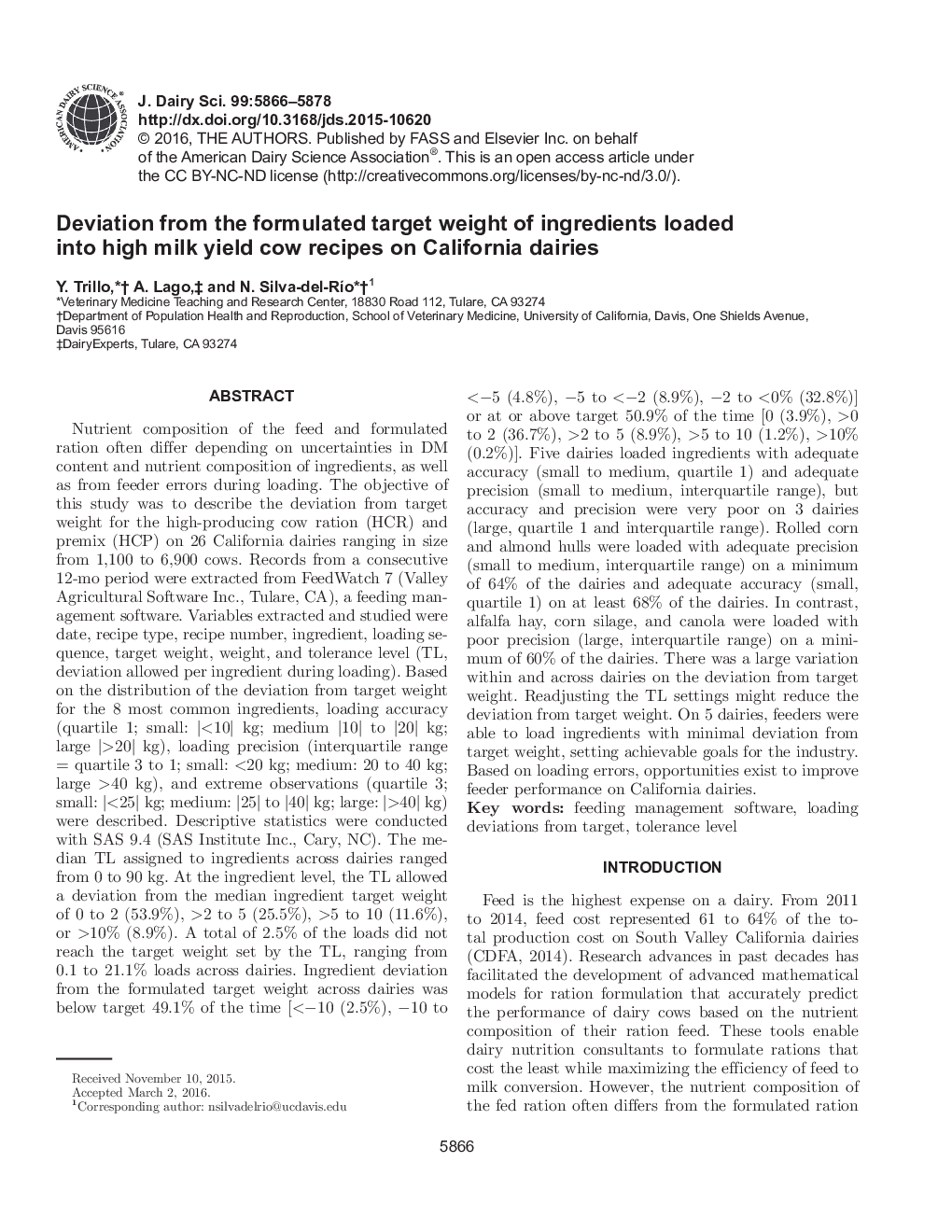| کد مقاله | کد نشریه | سال انتشار | مقاله انگلیسی | نسخه تمام متن |
|---|---|---|---|---|
| 10973683 | 1108017 | 2016 | 13 صفحه PDF | دانلود رایگان |
عنوان انگلیسی مقاله ISI
Deviation from the formulated target weight of ingredients loaded into high milk yield cow recipes on California dairies
ترجمه فارسی عنوان
انحراف از وزن هدف تشکیل شده از مواد تشکیل دهنده بارگیری شده در دستور العمل های تولید گاو شیری در لبنیات کالیفرنیا
دانلود مقاله + سفارش ترجمه
دانلود مقاله ISI انگلیسی
رایگان برای ایرانیان
کلمات کلیدی
تغذیه نرم افزار مدیریت، بارگیری انحراف از هدف، سطح تحمل،
موضوعات مرتبط
علوم زیستی و بیوفناوری
علوم کشاورزی و بیولوژیک
علوم دامی و جانورشناسی
چکیده انگلیسی
Nutrient composition of the feed and formulated ration often differ depending on uncertainties in DM content and nutrient composition of ingredients, as well as from feeder errors during loading. The objective of this study was to describe the deviation from target weight for the high-producing cow ration (HCR) and premix (HCP) on 26 California dairies ranging in size from 1,100 to 6,900 cows. Records from a consecutive 12-mo period were extracted from FeedWatch 7 (Valley Agricultural Software Inc., Tulare, CA), a feeding management software. Variables extracted and studied were date, recipe type, recipe number, ingredient, loading sequence, target weight, weight, and tolerance level (TL, deviation allowed per ingredient during loading). Based on the distribution of the deviation from target weight for the 8 most common ingredients, loading accuracy (quartile 1; small: |<10| kg; medium |10| to |20| kg; large |>20| kg), loading precision (interquartile range = quartile 3 to 1; small: <20 kg; medium: 20 to 40 kg; large >40 kg), and extreme observations (quartile 3; small: |<25| kg; medium: |25| to |40| kg; large: |>40| kg) were described. Descriptive statistics were conducted with SAS 9.4 (SAS Institute Inc., Cary, NC). The median TL assigned to ingredients across dairies ranged from 0 to 90 kg. At the ingredient level, the TL allowed a deviation from the median ingredient target weight of 0 to 2 (53.9%), >2 to 5 (25.5%), >5 to 10 (11.6%), or >10% (8.9%). A total of 2.5% of the loads did not reach the target weight set by the TL, ranging from 0.1 to 21.1% loads across dairies. Ingredient deviation from the formulated target weight across dairies was below target 49.1% of the time [<â10 (2.5%), â10 to <â5 (4.8%), â5 to <â2 (8.9%), â2 to <0% (32.8%)] or at or above target 50.9% of the time [0 (3.9%), >0 to 2 (36.7%), >2 to 5 (8.9%), >5 to 10 (1.2%), >10% (0.2%)]. Five dairies loaded ingredients with adequate accuracy (small to medium, quartile 1) and adequate precision (small to medium, interquartile range), but accuracy and precision were very poor on 3 dairies (large, quartile 1 and interquartile range). Rolled corn and almond hulls were loaded with adequate precision (small to medium, interquartile range) on a minimum of 64% of the dairies and adequate accuracy (small, quartile 1) on at least 68% of the dairies. In contrast, alfalfa hay, corn silage, and canola were loaded with poor precision (large, interquartile range) on a minimum of 60% of the dairies. There was a large variation within and across dairies on the deviation from target weight. Readjusting the TL settings might reduce the deviation from target weight. On 5 dairies, feeders were able to load ingredients with minimal deviation from target weight, setting achievable goals for the industry. Based on loading errors, opportunities exist to improve feeder performance on California dairies.
ناشر
Database: Elsevier - ScienceDirect (ساینس دایرکت)
Journal: Journal of Dairy Science - Volume 99, Issue 7, July 2016, Pages 5866-5878
Journal: Journal of Dairy Science - Volume 99, Issue 7, July 2016, Pages 5866-5878
نویسندگان
Y. Trillo, A. Lago, N. Silva-del-RÃo,
